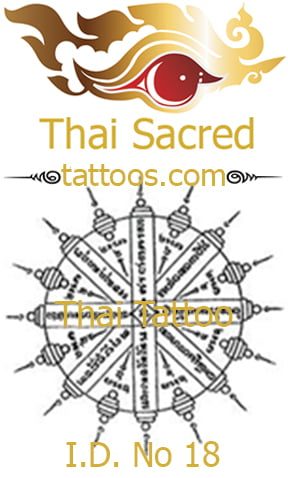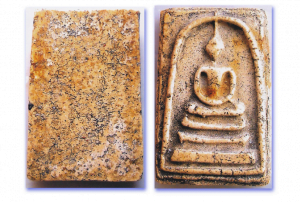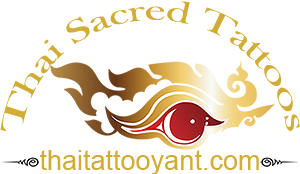Sacred Geometrical Thai Yantras and the Meaning
Sacred Geometrical Thai Yantras

- Sacred Geometrical Thai Yantras
- There are many various shapes of Yantras. A circular or round Yant indicates the face of Lord Buddha. This originates from Brahminism. A four-sided or square Yant signifies the four elements, earth, wind, fire, and water. A three-sided or triangular Yant means Buddha, Dhamma, and Sangha. Some Yants are of pictures and they represent various mythical figures and animal types.
- There are many different designs, each with its own special powers. Yants were (and still are) inscribed upon the cloth, metal, the walls of homes, and even shirts that give the wearer special protection. The Ong Phra (Buddha’s body) (องค์พระ) is a symbol of Lord Buddha and is seen frequently in Yantras. This is usually a series of oval shapes arranged on top of one another, ranging from large to small. It forms the basis of many sacred Yants. A crescent or half-moon shape indicates the illumination of darkness as we make our way through this life. A small round shape symbolizes the Sun that lights up our way ahead. If the circle is above the main Yant then this means the stars in the sky and indeed all celestial beings. This is common in many pictorial Yants.
- The ever-decreasing spirals as in Gao Yod (nine spirals) (เก้ายอด) signify the wavering that this earthly life bestows upon us. At the top, when the line goes straight up signifies that the person has attained control over these earthly desires and attachments and is ready to enter Nirvana or true enlightenment. This symbol is called an Unnalom and the central spire represents Buddha himself.
- These Yants are brought to life by the chanting of Khatas which are usually in Pali script and often accompanied by repeated blowing by the chanter. This is believed to increase the power of the Yant if done correctly. These incantations must be spoken a certain number of times, depending on the specific Yant. As some of these Khatas are very long and repetitive, numbers are often used to shorten the chanting process.
Quite often, when a Ruesi (Sak Yant master) performs his Khata, it invokes spirits which enter the bodies of those present, causing them to gyrate or mimick the animal they represent. Usually, the person regains consciousness and does not remember what happened just before. - The Katas are inscribed on cloth and many Sak Yant masters have created their own Khatas that they use with their disciples.
- There are other popular designs,
- Hah Taew (five lines) (ห้าแถว) is a very popular Yant and is said to be the first Tattoo a disciple should have. Popular in Thailand with both men and women, the five lines signify different areas of good fortune and health. This Yant is usually on the shoulder or the nape of the neck.
- Gao Yod (9 spires) (เก้ายอด) and See Yod (4 spires) (สี่ยอด) are also popular and are said to offer the bearer certain protections as well as the power to influence others. These two designs can vary greatly in both detail and size. The See Yod is often inscribed on copper or other precious metals such as silver or even lead. Then it can be rolled up and worn on the body, perhaps in a small glass tube or other small containers. It is said that rubbing this on either the left or right side produces influential power when talking to others. It is even said to win the bearer added influence in romantic encounters. This Yant is said to invoke mercy from others around the wearer and therefore can be extremely useful in certain situations.
- Baird dtit (8 dots) (แปดทิศ) is usually a large circular shape which represents the universe and sip dtit (10 dots) (สิบทิศ) is said to have a wider protection range than the previous one.
- Yod Mongkut (spiral crown) (ยอดมงกุฎ) is usually found on the head and used mainly for combat. This was a very common Yant found on Thai soldiers in the Ayutthaya period and onward from that time.
- A tiger (or pair of tigers) (เสือ) is said to bring the bearer power and authority and is another very common tattoo in Thailand.
- Important points to remember about Sak Yant:
- The Khata must be read by the Sak Yant master and it must be chanted correctly. The bearer must adhere to certain rules such as not drinking too much alcohol and be annoying to others. These rules (Khor Haam) (ข้อห้าม๗๗) vary from master to master but are generally basic good living precepts that one should adhere to anyway. Failure to comply with these rules renders the Yant powerless. The Ruesi master will inform the bearer of these rules before performing the Sak Yant as they must be understood fully beforehand.
Sacred Geometrical Thai Yantras. If the bearer breaks one or more of the rules, he can return to the master and have the yant “re-energized”
Professional Sak Yant Masters and Tattoo Artists
Our Sak Yant Thai Tattoo Masters have done their time as disciples and trained for many years. They are fully qualified Sak Yant masters and trained by Grand Masters. Our masters are certified by the Thai government as genuine masters.
5 Stars Services
We give the best experience that can be given, right from the time we reply to your inquiry to getting the best tattoo and blessing done. Then you can give a review of the experience.
Clean Sterilize Equipment
New needles every time and ink imported from the USA. We are one of the cleanest studios in the world. The Studio is certified to the highest hygiene by the government. Inspected and licensed to operate as a tattoo studio. All artists/masters are tested every year for blood diseases. We are as good as western standards or better.
Bangkok Ink Tattoo Group Associates in Business
Tiger Web Geek, Website Design, Hosting, SEO, Marketing
Thai Tattoos Sacred Sak Yant Tattoo Studio, Hand Poke Tattoo Thailand Bangkok
Thai Tattoo Sak Yant UK Tours
Bangkok Ink Studio, Machine, Hand Poke Tattoos, Tattoo Removal, VIP Service to Ajarn Ohr
Tattoo School Thailand Bangkok
Asian Artifacts oneshopasia.com
Thai Tattoo Sak Yant USA Tours
...
Skindiver.se Gothenburg Sweden
Revolttattoos.com USA, Las Vegas, Tattoo Masters Joey and Walter
Happysailortattoo.com Old School Tattooing
Sacred Art Tattoo Studio Manchester UK
Skin Graffiti Tattoo Studio UK
Dark Mofo Tasmania
Skin Diver Tattoo Studio
Ink Tattoo Studio
Everyday Tattoo Studio Bangkok


